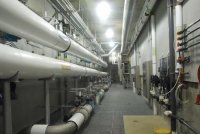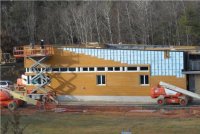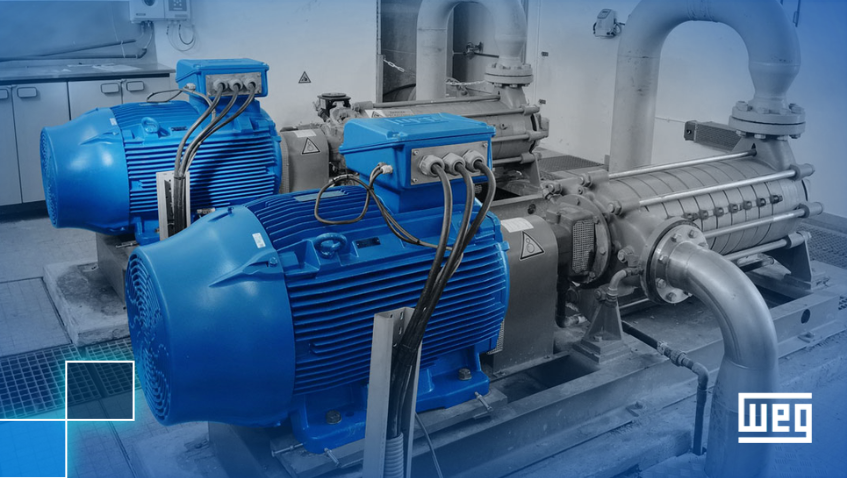From the outside, the new water treatment plant in Madbury, N.H., may look merely average. In reality, it includes many forward-thinking, energy-saving elements and was scheduled to become the first water treatment facility in the state to receive the Leadership in Energy and Environmental Design (LEED) silver certification in summer 2012. Although LEED requires a new building to achieve 10 percent energy savings over a baseline design, estimates indicate that the Madbury plant’s energy savings may exceed 24 percent — or $35,000 per year.
Stepping forward
The $20 million plant, managed by the City of Portsmouth and serving 37,000 people in five communities in southeastern New Hampshire, went online in August 2011. Ten years earlier, the city’s 1958 treatment plant was becoming less reliable and more expensive to repair, and it struggled to keep up with regulatory requirements.
Portsmouth began an 18-month study to analyze existing assets, future needs and the sustainable yield of the community’s water sources — nine wells and the Bellamy Reservoir. The area water is highly colored due to high organic content, and removing the organics and avoiding disinfection byproducts were big concerns.
Based on the results of a pilot test, the city chose dissolved air flotation (DAF) as the best treatment option. Portsmouth, led by city engineer Peter Rice, partnered with design engineering company Hazen and Sawyer for design and construction administration of the new plant, which processes an average of 2.5 mgd and has 6 mgd capacity.
Sustainability in mind
Sustainable design was a top priority, and that meant using as much of the existing plant as possible, while choosing sustainable design elements that would be the most cost-effective in the long term. To achieve its goals, the city built the facility to LEED standards. “It gives validity to the process, formalizes the structure, and keeps people focused throughout design and construction,” Rice says. “LEED gave us more control to make sure the contractor did what we wanted them to do.”
Achieving LEED certification requirements proved challenging because the process was not designed for industrial buildings. To meet the requirements, the energy efficiency of the treatment process, HVAC and lighting all had to be optimized to maximize overall efficiency. Through an integrated design approach, all engineering disciplines worked together to identify improvements that would add significant savings.
“We worked to clearly identify ‘light green’ versus ‘dark green’ types of upgrades,” Rice says. “There are some environmental technologies that may look great for public consumption, like windmills, photovoltaic cells or rain gardens. But if you look at the life-cycle costs and the benefits, often they don’t pay out. So we focused on improvements that at first glance may not appear as ‘gee whiz’ things.”
Efficient envelope
The plant was designed with a tight, efficient envelope to minimize energy waste. Extra insulation in the walls and super-insulated windows provide a barrier to prevent heat loss. In addition, the various zones of the treatment plant are segregated to avoid cross-contamination of the air that would require more dehumidification. “It’s not necessarily the most exciting thing to put more detailed design into the insulation of walls and the building envelope,” says Hazen and Sawyer project manager Matt Valade. “But we were able to significantly reduce the energy requirements for the heating and ventilation of the system. Through an energy model we developed, we showed that those things significantly reduced energy consumption.”
Process water heat pumps assist in heating and cooling the building. To supplement the HVAC system, process water heat exchangers provide heat during winter and pump refrigerant for cooling in summer. In the chemical storage areas where emergency shower and eyewash stations require tepid water, solar panels provide 6,000 kWh annually to maintain the water temperature. A more traditional water heater design would have required higher capital cost for a larger backup generator and a larger electrical transformer.
The HVAC system draws energy from utility electricity, liquid propane gas (LPG), the process water heating, and the solar panels. Although the heat pumps require more electricity, that increased demand is recovered through lower demand for LPG. The total energy savings for the HVAC system are projected at 44 percent annually compared to a baseline building. Exact savings calculations won’t be available until the plant has been online for more than 12 months.
During winter, cold intake water in the long runs of piping creates a heat sink within the occupied sections of the building. One-inch insulation was added to long straight process runs of piping and to tank walls in the pipe gallery. The extra insulation cost $35,000, and the calculated payback period is 13 years.
Reducing power demand
The plant reduces energy consumption in its four 100 hp finished water pumps and three 25 hp DAF recycle pumps by using variable frequency drives to control speed in WEG Premium Efficiency motors.
The city also saves by shifting some plant processes, such as filter backwashing, to lower-demand times of day to take advantage of off-peak electricity rates. To reduce energy for lighting, the plant takes advantage of daylighting with large windows and translucent walls on the southern side. Despite the new plant’s greater capabilities, daily operation is more automated and simpler than in the old plant. Operators no longer climb into tanks for weekly cleaning because sludge is pumped out automatically. Hazen and Sawyer supports troubleshooting for the facility but is training the Madbury operators to be self-sufficient with maintenance.
by Lisa Balcerak
Republished with permision of WSO Magazine (www.wsomag.com)






